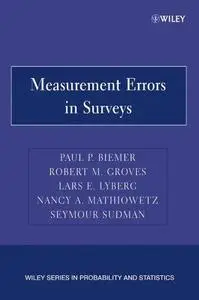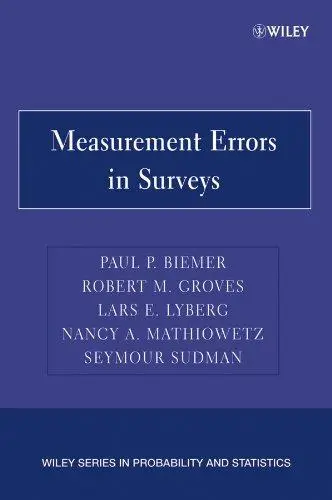Measurement Errors in Surveys By
2004 | 770 Pages | ISBN: 0471692808 | PDF | 19 MB
2004 | 770 Pages | ISBN: 0471692808 | PDF | 19 MB
WILEY-INTERSCIENCE PAPERBACK SERIES The Wiley-Interscience Paperback Series consists of selected books that have been made more accessible to consumers in an effort to increase global appeal and general circulation. With these new unabridged softcover volumes, Wiley hopes to extend the lives of these works by making them available to future generations of statisticians, mathematicians, and scientists. "This book will be an aid to survey statisticians and to research workers who must work with survey data." –Short Book Reviews, International Statistical Institute Measurement Errors in Surveys documents the current state of the field, reports new research findings, and promotes interdisciplinary exchanges in modeling, assessing, and reducing measurement errors in surveys. Providing a fundamental approach to measurement errors, the book features sections on the questionnaire, respondents and responses, interviewers and other means of data collection, the respondent-interviewer relationship, and the effects of measurement errors on estimation and data analysis.Content: Chapter 1 Measurement Error Across Disciplines (pages 1–25): Robert M. GrovesChapter 2 The Current Status of Questionnaire Research (pages 27–40): Norman M. Bradburn and Seymour SudmanChapter 3 Response Alternatives: The Impact of Their Choice and Presentation Order (pages 41–56): Norbert Schwarz and Hans?Jurgen HipplerChapter 4 Context Effects in the General Social Survey (pages 57–71): Tom W. SmithChapter 5 Mode Effects of Cognitively Designed Recall Questions: A Comparison of Answers to Telephone and Mail Surveys (pages 73–93): Don A. Dillman and John TarnaiChapter 6 Nonexperimental Research on Question Wording Effects: A Contribution to Solving the Generalizability Problem (pages 95–111): Nico MolenaarChapter 7 Measurement Errors in Business Surveys (pages 113–123): Solomon Dutka and Lester R. FrankelChapter 8 Recall Error: Sources and Bias Reduction Techniques (pages 125–144): Donna Eisenhower, Nancy A. Mathiowetz and David MorgansteinChapter 9 Measurement Effects in Self vs. Proxy Response to Survey Questions: An Information?Processing Perspective (pages 145–166): Johnny Blair, Geeta Menon and Barbara BickartChapter 10 An Alternative Approach to Obtaining Personal History Data (pages 167–183): Barbara Means, Gary E. Swan, Jared B. Jobe and James L. EspositoChapter 11 The Item Count Technique as a Method of Indirect Questioning: A Review of Its Development and a Case Study Application (pages 185–210): Judith Droitcour, Rachel A. Caspar, Michael L. Hubbard, Teresa L. Parsley, Wendy Visscher and Trena M. EzzatiChapter 12 Toward a Response Model in Establishment Surveys (pages 211–233): W. Sherman Edwards and David CantorChapter 13 Data Collection Methods and Measurement Error: An Overview (pages 235–257): Lars Lyberg and Daniel KasprzykChapter 14 Reducing Interviewer?Related Error Through Interviewer Training, Supervision, and Other Means (pages 259–278): Floyd J. FowlerChapter 15 The Design and Analysis of Reinterview: An Overview (pages 279–301): Gosta Forsman and Irwin SchreinerChapter 16 Expenditure Diary Surveys and Their Associated Errors (pages 303–326): Adriana R. Silberstein and Stuart ScottChapter 17 A Review of Errors of Direct Observation in Crop Yield Surveys (pages 327–346): Ron FecsoChapter 18 Measurement Error in Continuing Surveys of the Grocery Retail Trade Using Electronic Data Collection Methods (pages 347–364): John E. Donmyer, Frank W. Piotrowski and Kirk M. WolterChapter 19 Conversation with a Purpose—or Conversation? Interaction in the Standardized Interview (pages 365–391): Nora Cate SchaefferChapter 20 Cognitive Laboratory Methods: A Taxonomy (pages 393–418): Barbara H. Forsyth and Judith T. LesslerChapter 21 Studying Respondent?Interviewer Interaction: The Relationship Between Interviewing Style, Interviewer Behavior, and Response Behavior (pages 419–437): Johannes van der Zouwen, Wil Dijkstra and Johannes H. SmitChapter 22 The Effect of Interviewer and Respondent Characteristics on the Quality of Survey Data: A Multilevel Model (pages 439–461): Joop J. Hox, Edith D. de Leeuw and Ita G. G. KreftChapter 23 Interviewer, Respondent, and Regional Office Effects on Response Variance: A Statistical Decomposition (pages 463–483): Daniel H. HillChapter 24 Approaches to the Modeling of Measurement Errors (pages 485–516): Paul Biemer and S. Lynne StokesChapter 25 A Mixed Model for Analyzing Measurement Errors for Dichotomous Variables (pages 517–530): Jeroen PannekoekChapter 26 Models for Memory Effects in Count Data (pages 531–549): Piet G. W. M. van DosselaarChapter 27 Simple Response Variance: Estimation and Determinants (pages 551–574): Colm O'MuircheartaighChapter 28 Evaluation of Measurement Instruments Using a Structural Modeling Approach (pages 575–597): Willem E. Saris and Frank M. AndrewsChapter 29 Path Analysis of Cross?National Data Taking Measurement Errors into Account (pages 599–616): Ingrid M. E. MunckChapter 30 Regression Estimation in the Presence of Measurement Error (pages 617–635): Wayne A. FullerChapter 31 Chi?Squared Tests with Complex Survey Data Subject to Misclassification Error (pages 637–663): J. N. K. Rao and D. Roland ThomasChapter 32 The Effect of Measurement Error on Event History Analysis (pages 665–685): D. Holt, J. W. McDonald and C. J. Skinner



